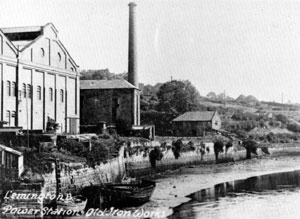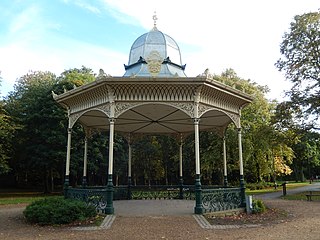
Newcastle upon Tyne, or simply Newcastle, is a city and metropolitan borough in Tyne and Wear, England. It is England's northernmost metropolitan borough, located on the River Tyne's northern bank opposite Gateshead to the south. It is the most populous settlement in the Tyneside conurbation and North East England.

Tyne and Wear is a ceremonial county in North East England. It borders Northumberland to the north and County Durham to the south, and the largest settlement is the city of Newcastle upon Tyne.

Prudhoe is a town and civil parish in the south of Northumberland, England. It is 11 miles (18 km) west of Newcastle upon Tyne and situated on a steep, north-facing hill on the south bank of the River Tyne. Prudhoe had a population of 11,675 at the 2011 census, making it the second largest town in the Tyne Valley after Hexham.

The Tyne Bridge is a through arch bridge over the River Tyne in North East England, linking Newcastle upon Tyne and Gateshead. The bridge was designed by the engineering firm Mott, Hay and Anderson, who later designed the Forth Road Bridge, and was built by Dorman Long and Co. of Middlesbrough. The bridge was officially opened on 10 October 1928 by King George V and has since become a defining symbol of Tyneside. It is ranked as the tenth tallest structure in Newcastle.

Wylam is a village and civil parish in the county of Northumberland, England. It is located about 10 miles (16 km) west of Newcastle upon Tyne.

Eldon Square is a shopping centre in Newcastle upon Tyne, England. It opened in 1976 and was built on the site of Old Eldon Square, a famous part of Georgian Newcastle designed by John Dobson in about 1824. This redevelopment, which left only the eastern terrace standing, has been criticised, with one writer calling it "the greatest single example of architectural vandalism in Britain since the war".

Newburn is a village and district of Newcastle upon Tyne, in Tyne and Wear, England. Situated on the North bank of the River Tyne, it is built rising up the valley from the river. It is situated approximately 5 miles (8 km) from the city centre, 14 miles (23 km) east of Hexham and 13 miles (21 km) south south west of Morpeth. In the 2001 census, the population was given as 9,301, increasing to 9,536 at the 2011 Census. Newburn is in the Newcastle upon Tyne district of Tyne and Wear and is part of the parliamentary constituency of Newcastle upon Tyne North.

Gosforth is an area of Newcastle upon Tyne, England, situated north of the City Centre. It constituted a separate urban district of Northumberland from 1895 until 1974 before officially merging with the city of Newcastle upon Tyne. In 2001, it had a population of 23,620.
The Town Moor is an area of common land in Newcastle upon Tyne. It covers an area of around 1,000 acres (400 ha), making it larger than Hyde Park and Hampstead Heath combined. It is also larger than New York City's Central Park. The Town Moor reaches Spital Tongues and the city centre to the south, Gosforth to the north and Jesmond to the east.

Wylam Railway Bridge is a footbridge and former railway bridge crossing the River Tyne at Hagg Bank, approximately 1⁄2 mile (0.8 km) west of Wylam in Northumberland, England.

Lemington Power Station was a small, now demolished coal-fired power station, located in North East England. It was situated on the Lemington Gut, a backwater of the River Tyne, at Lemington, 3.5 mi (5.6 km) west of Newcastle upon Tyne. The station's main building stood until 2017 as a rare example of an early power station, dating from before the nationalisation of the United Kingdom's electrical supply industry.

Wylam Bridge is a road bridge in Northumberland, England linking the residential area of North Wylam and neighbouring villages of Heddon-on-the-Wall, and Horsley with the railway station in South Wylam as well as west Gateshead, including the villages of Ryton and Crawcrook.
Northern Pride is the biggest LGBT Pride festival in the North East of England, hosted in Newcastle upon Tyne. It is held in July every year on the Town Moor, just outside the City Centre. The event is free for all who attend and offers music, stalls and a safe space for LGBT+ people, their families and friends. Northern Pride is a celebration of LGBT+ culture, history and societal diversity.

The Tuxedo Princess and Tuxedo Royale were two former car ferries used as permanently moored floating nightclubs in the United Kingdom from the 1980s to the 2000s. Both ships saw use on the River Tyne at different times, while the Princess also saw use on the River Clyde in Glasgow, and the Royale on the River Tees in Middlesbrough.

The North East Coast Exhibition was a world's fair held in Newcastle, Tyne and Wear and ran from May to October 1929. Held five years after the British Empire Exhibition in Wembley Park, London, and at the start of the Great Depression the event was held to encourage local heavy industry.
Narbi Price born in Hartlepool, UK, in 1979, is a British painter and curator.

The Royal Mining Engineering Jubilee Exhibition was held in 1887 at Newcastle's Town Moor, Newcastle upon Tyne and Bull Park (renamed the Exhibition Park later in 1929.
Statue of Industry was a 1929 sculpture by the English artist Herbert Maryon. The 23-foot (7-metre) tall work depicted a woman with a model of Tyne-built RMS Mauretania in one hand, a model of a turbo alternator in the other, and three children at her feet. It was a prominent attraction at the North East Coast Exhibition, a world's fair-type event in Newcastle intended to showcase the manufacturing-centric capabilities of a region which was in the midst of a post-war recession. It remained at the Exhibition from May 1929 opening to October 1929 closing. Afterwards, the plaster-on-steel statue was copper-metalized to better withstand the elements, and sold to the engineering firm A. Reyrolle & Company in Hebburn; it remained there until at least 1931.


















